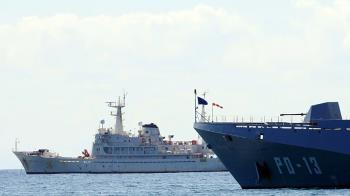Alwaght- Being the world’s largest oil importer, China is an influential player, holding permanent economic and energy interests in the Middle East. While the US dependence on oil supplied by the Middle Eastern producers has seen a shrink in the recent years, China imports roughly half of its crude from the Persian Gulf countries. This amount could see a rise as the Chinese state energy companies invest in Iraq and Iran energy projects, and as Beijing is developing closer ties with Saudi Arabia.
Should the oil supply process suffers an interruption due to insecurity in the region, China’s vital interests by far could be exposed to jeopardy. Therefore, it is senseful to assume that as the time goes by, China intensifies interventions in the Persian Gulf region. The question is that what are the other works Beijing wants to do in the region in the future?
To guarantee security of its commercial and energy interests in the region, China has held close relations with the two major rivals in the region Saudi Arabia and Iran- a job seen not easy for Beijing to accomplish.
The Chinese President Xi Jinping was the first foreign leader to visit Iran after Tehran signed its nuclear deal with the P5+1. Earlier in September 2014 for the first time in the history of Chinese-Iranian ties, two Chinese warships docked at Bandar Abbas Port, home to Iran’s largest naval facility.
On the other side, the Chinese president in his latest visit of the region in January 2016 has talked with the Persian Gulf Arab leaders about establishing a free trade zone between the two sides. The two sides are expected to finalize a free trade agreement (FTA) within a year.
The Persian Gulf states have a growing sense that China could present a reliable trade partner for the future, as due to its deep dependence to oil imported from them, they see Beijing remains the long-term purchaser of their oil. Just like Russia, China has offered its civil nuclear capabilities to the Persian Gulf countries.
Saudi Arabia, due to discontent with the US over nuclear cooperation, is seeking ways to boost work with China. It recently signed a nuclear agreement with the Chinese company China Nuclear Engineering Construction Corporation (CNECC) to build 16 nuclear reactors for the kingdom by 2032.
The arms trade between China and the Persian Gulf Arab states is relatively small in amount, however, a specific weapon that some Arabs are eyeing to buy from Beijing is the combat drones. For example, the UAE appears to be the first foreign purchaser of the Chinese strike drone Wing Loong. A resistant unmanned aerial vehicle (UAV) and similar to the US drone MQ-1, the Wing Loong is capable of flying for a long time at mid-altitude.
MQ-1 is an attack UAV used by both the US’ CIA and the Department of the Defense. Equipped with sensors and accurate cameras, and capable of carrying missiles, the MQ-1 has been used in Iraq, Pakistan, Yemen, Libya and Bosnia. China’s Wing Loong is capable of reconnaissance and carrying two air-to-ground missiles.
It appears that Saudi Arabia has used the China-made combat drones to strike the Al-Qaeda in the Arabian Peninsula (AQAP), as well as the revolutionary forces of Ansarullah in the neighboring Yemen.
In their private talk, the Arab leaders almost always told their American allies of how useful the Chinese drones were for military operations.
For the time being China is a huge economic power present in the Middle East, but its economic weight in the region is to be felt in the upcoming years.
Although China is not yet seen as a major political and security player, it very likely would expand its role in the region in the future through deepening mutual energy trade dependence and also through accomplishing New Silk Road plan. The New Silk Road project- with One Belt, One Road as its slogan-was proposed in 2013 by China’s Xi Jinping in a bid to revive the economic belt of the ancient Silk Road. Accomplishment of the project with contribution of the countries along the Silk Road could potentially engage a population of about 3 billion people into a new and massive market. The project seeks building transportation infrastructures moving through Eurasia, Middle East and Europe.
With a $40 billion allocation to launch infrastructure projects of the major check points along the ancient Silk Road including the routes crossing the Middle East, China certainly sees itself committed to security of the Middle East.
Now China has decided to take a bigger role in West Asia and has tried to mediate for peace in Afghanistan. It also attempts to have its say on Israeli-Palestinian conflict more clearly. It supports Baghdad in its anti-ISIS fight, and holds closer ties with Saudi Arabia and Iran.
In terms of naval power, it is very likely that China engages further in providing security of the Persian Gulf region, as Beijing between 2009 and 2015 has sent 19 naval fleets to the Gulf of Aden and Somali coasts.
The Chinese vessels’ mission largely focuses on maritime diplomacy, fighting piracy and oceanic rescue operations. However, to show off a shift from soft approach to a hard attitude of military presence, China in May 2015 held joint military drills with Russia in the Mediterranean Sea. Dubbed Joint Sea 2015, the naval exercises lasted for five days and the two sides used 9 huge warships during the drills. The aim of the joint exercises was announced to be deepening the friendly collaborations of Moscow and Beijing and enhancing the naval capabilities in a bid to address any maritime security threats.
For China the naval drills were part of a large-scale strategy to transform into a sea power which in its place is part of Beijing’s One Belt, One Road strategy which comes with the objective of connecting Eurasia’s large economies through building infrastructures and bolstering trade and investment.



























